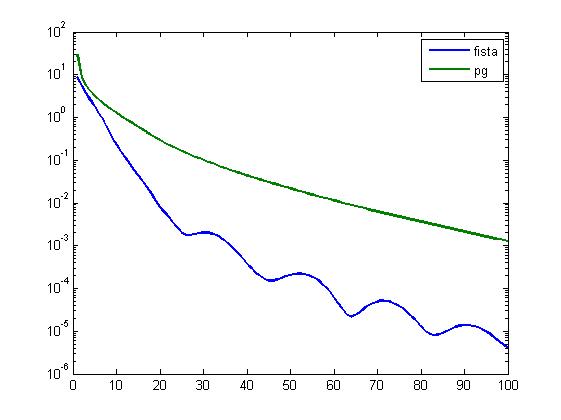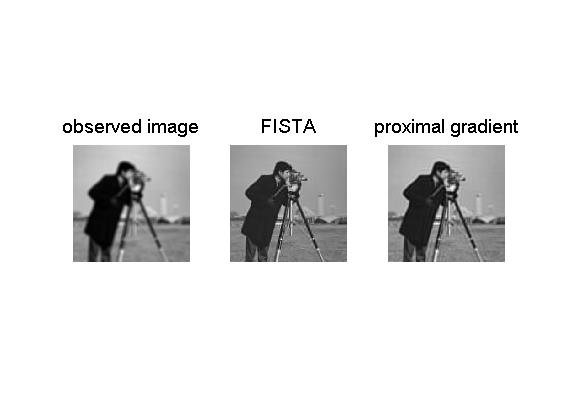General Description:
FISTA method for solving problems of the form
Assumptions:
Available Oracles:
(the function values of f and g are not required in the economical setting)
Usage:
out = fista(Ffun,Ffun_grad,Gfun,Gfun_prox,lambda,startx,[par]) [out,fmin] = fista(Ffun,Ffun_grad,Gfun,Gfun_prox,lambda,startx,[par]) [out,fmin,parout] = fista(Ffun,Ffun_grad,Gfun,Gfun_prox,lambda,startx,[par]) Input:
Ffun - function handle for f
Ffun_grad - function handle for the gradient of f
Gfun - function handle for g (if g is extended real-valued, it is enough to specify the operation of g on its domain)
Gfun_prox - function handle for the proximal mapping of g times a positive constant
lambda - positive scalar
startx - starting vector
par - struct containing different values required for the operation of fista
Output:out - optimal solution (up to a tolerance) fmin - optimal value (up to a tolerance) parout - a struct containing containing additional information related to the convergence. The fields of parout are: iterNum - number of performed iterations
funValVec - vector of all function values generated by the method Method Description:
Employs FISTA for solving
using the following update scheme:
where L_k is either constant (if const_flag is true) or chosen by backtracking (default). The backtracking procedure either keeps L_k as it is, or increases it - each time by a multiplicative factor of eta. If regret_flag is true, then at the beginning of each iteration L_k is divided by eta. If monotone_flag is true, then a variation of the above update rule that keeps the sequence of function values monotone nonincreasing is employed.
The method stops when at least one of the following conditions hold: (1) the number of iterations exceeded max_iter (2) the norm of the difference between two consecutive iterates is smaller than eps (the latter stopping criteria is only relevant if monotone_flag is false)
References:
Consider the problem
where A and b are generated by the following commands
>> randn('seed',315);>> A=randn(80,100);>> b=randn(80,1);We solve the problem using 100 iterations of FISTA by taking f(x)=0.5*norm(A*x-b,2)^2, lambda=2 and g(x)=norm(x,1). We use the fact that A'*(A*x-b) is the gradient of f and the function prox_l1, which is part of the package (for a list of available prox functions, go here)
>> clear par>> par.max_iter=100;>> [out,fmin,parout_fista] =fista(@(x)0.5*norm(A*x-b,2)^2,@(x)A'*(A*x-b),@(x)norm(x,1),...@(x,a)prox_l1(x,a),2,zeros(100,1),par);*********************
FISTA
*********************
#iter fun. val. L val.
1 23.720870 256.000000
2 20.469023 256.000000
3 18.708294 256.000000
4 17.547646 256.000000
: : :
83 14.988554 256.000000
97 14.988553 256.000000
98 14.988552 256.000000
99 14.988551 256.000000
100 14.988550 256.000000
----------------------------------
Optimal value = 14.988550
Note that all the Lipschitz estimates were chosen as 256, meaning that the backtracking procedure had an effect only at the first iteration (in which the initial Lipschitz estimate 1 was increased to 256).
Running the proximal gradient with the same input produces a higher function value
>> [out,fmin,parout_pg] =prox_gradient(@(x)0.5*norm(A*x-b,2)^2,@(x)A'*(A*x-b),@(x)norm(x,1),@(x,a)prox_l1(x,a),2,zeros(100,1),par);*********************
prox_gradient*********************#iter fun. val. L val. 1 44.647100 256.000000 2 23.720870 256.000000 3 20.469023 256.000000 4 19.039811 256.000000 : : :
96 14.990101 256.000000 97 14.990022 256.000000 98 14.989947 256.000000 99 14.989876 256.000000 100 14.989808 256.000000----------------------------------Optimal value = 14.989744 To make a more detailed comparison between the two methods we plot the distance to optimality in terms of function values of the sequences generated by the two methods. The optimal value is approximated by 10000 iterations of FISTA.
>> clear par;>> par.max_iter=10000;>> [out,fmin_accurate]=fista(@(x)0.5*norm(A*x-b,2)^2,@(x)A'*(A*x-b),@(x)norm(x,1),@(x,a)prox_l1(x,a),2,zeros(100,1),par);>> semilogy(1:100,parout_fista.funValVec-fmin_accurate,1:100,parout_pg.funValVec-fmin_accurate,'LineWidth',2);>> legend('fista','pg');Example 2:
In this example we consider the problem
where A represents a blurring operator with a Gaussian PSF and W is an orthogonal wavelet transform. b is the observed image. The l1 norm on W(x) is the natural extension of the l1 norm on vectors, meaning that it stands for the sum of absolute values of the components of W(x) (it is not the induced l1 matrix norm).
We begin by generating the "true" image, which in this case will be the cameraman.
>> X = double(imread ('cameraman.pgm') );>> X = X/255;>> [P,center] = psfGauss([9,9],4)The function psfGauss was taken from the HNO library written by Per Christian Hansen, James G. Nagy, and Dianne P. O'Leary for the book "Deblurring Images: Matrices, Spectra and Filtering". The observed image is produced by blurring X followed by the addition of some noise.
>> B = imfilter(X,P,'symmetric') ;>> randn('seed',314);>> Bobs = B + 1e-3*randn(size(B));We can plot the "true" and "observed" images.
The function handles for the objective function and its gradient are
>> fpic = @(x) norm(imfilter(x,P,'symmetric') - Bobs,'fro')^2;>> grad_fpic = @(x) 2* imfilter(imfilter(x,P,'symmetric')-Bobs,P,'symmetric');The wavelet transform used in this example is taken from the "numerical tours of signal processing" written by Gebriel Peyre that can be downloaded from the MATLAB's file exchange website.
>> options.ti=0;>> Jmin=4;>> w= @(f) perform_wavelet_transf(f,Jmin,+1,options);>> wi= @(f) perform_wavelet_transf(f,Jmin,-1,options);The function g and its prox mapping are implemented next.
>> Gpic = @(x) sum(sum(abs(w(x))));>> prox_gpic = @(x,a) wi(prox_l1(w(x),a));In the above we used the fact that since W is an orthogonal transformation, it holds that
We now run 100 iterations of FISTA and the proximal gradient method. The image produced by FISTA is significantly better than the one generated by the proximal gradient method.
>> clear par>> par.max_iter = 100;>> x_fista= fista(@(x)fpic(x),@(x) grad_fpic(x), @(x) Gpic(x), @(x,alpha)prox_gpic(x,alpha),0.001,zeros(size(Bobs)),par);>> x_pg=prox_gradient(@(x)fpic(x),@(x) grad_fpic(x), @(x) Gpic(x), @(x,alpha)prox_gpic(x,alpha),0.001,zeros(size(Bobs)),par);>> figure(2)>> subplot(1,3,1)>> imshow(Bobs,[])>> title('observed image','FontSize',14)>> subplot(1,3,2)>> imshow(x_fista,[])>> title('FISTA','FontSize',14)>> subplot(1,3,3)>> imshow(x_pg,[])>> title('proximal gradient','FontSize',14)*********************FISTA*********************#iter fun. val. L val. 1 62.790523 2.000000 2 23.292874 2.000000 3 12.229700 2.000000 4 8.239808 2.000000 : : :
97 3.040138 2.000000 98 3.039991 2.000000 99 3.039849 2.000000 100 3.039708 2.000000----------------------------------Optimal value = 3.039708 *********************prox_gradient*********************#iter fun. val. L val. 1 17380.441112 2.000000 2 62.790523 2.000000 3 23.292874 2.000000 4 13.973323 2.000000 : : :
96 3.262200 2.000000 97 3.259289 2.000000 98 3.256438 2.000000 99 3.253645 2.000000 100 3.250909 2.000000----------------------------------Optimal value = 3.248227 Obviously, the image produced by FISTA is better than the one generated by the proximal gradient. This is also reflected by the obtained function values (3.039708 for the FISTA and 3.248227 for the proximal gradient method).
Example 3:
Consider the problem
where
>> A=[1,2,0;2,1,2;0,2,1];>> B=[1,0,-1;2,1,3];>> b=[1;-1];We will solve the problem using FISTA by taking
In MATLAB,
>> f=@(x)norm([1;A*x]);>> f_grad=@(x)A'*(A*x)/norm([1;A*x]);>> binv=B\b;>> g=@(x)norm(B*x+b);>> prox_g=@(x,a)prox_norm2_linear(x+binv,B,a)-binv;Running FISTA on the problem yields >> [out,fmin,parout]=fista(f,f_grad,g,prox_g,1,zeros(3,1));*********************FISTA*********************#iter fun. val. L val. 1 1.311762 2.000000 2 1.289577 8.000000 3 1.284966 8.000000 4 1.284646 8.000000 7 1.284643 8.000000 8 1.284643 8.000000 10 1.284643 8.000000 11 1.284643 8.000000Stopping because the norm of the difference between consecutive iterates is too small----------------------------------Optimal value = 1.284643 Note that the overall number of iterations is 13 (the last displayed iteration number is 11 since the function value did not improve in the last two iterations). >> parout.iterNumans = 13Note that the method stopped before it reached the maximum number of iterations (default=1000) since the distance between the last two consecutive iterate vectors was smaller than the default of par.eps (1e-5). We can tighten this parameter to 1e-7. >> par.eps=1e-7>> [out,fmin,parout]=fista(f,f_grad,g,prox_g,1,zeros(3,1),par);*********************FISTA*********************#iter fun. val. L val. 1 1.311762 2.000000 2 1.289577 8.000000 3 1.284966 8.000000 4 1.284646 8.000000 7 1.284643 8.000000 8 1.284643 8.000000 10 1.284643 8.000000 11 1.284643 8.000000 15 1.284643 8.000000 18 1.284643 8.000000Stopping because the norm of the difference between consecutive iterates is too small----------------------------------Optimal value = 1.284643 >> parout.iterNumans = 20This time the method stopped after 20 iterations. If we want to enforce the method to employ the default of 1000 iterations, then we can set par.eps to 0. >> par.eps=0>> [out,fmin,parout]=fista(f,f_grad,g,prox_g,1,zeros(3,1),par);*********************FISTA*********************#iter fun. val. L val. 1 1.311762 2.000000 2 1.289577 8.000000 3 1.284966 8.000000 4 1.284646 8.000000 7 1.284643 8.000000 8 1.284643 8.000000 10 1.284643 8.000000 11 1.284643 8.000000 15 1.284643 8.000000 18 1.284643 8.000000 21 1.284643 8.000000 22 1.284643 8.000000 25 1.284643 8.000000 26 1.284643 8.000000 28 1.284643 8.000000 29 1.284643 8.000000 31 1.284643 8.000000----------------------------------Optimal value = 1.284643 >> parout.iterNumans = 1000Note that no function value is printed after iteration 31 since the objective function value was not improved (although 1000 iterations were employed). |
Solvers >



